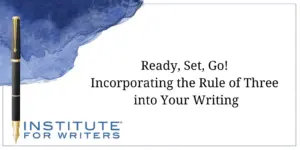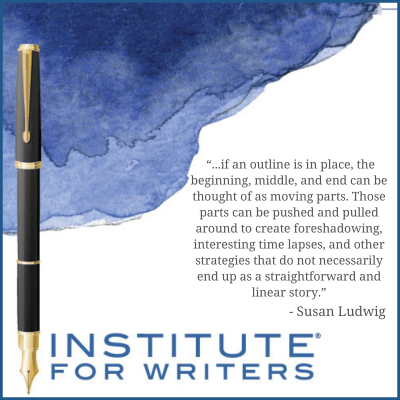
Finding and Working With a Literary Agent
Finding and securing a literary agent is just as difficult as it is to land a good publisher for your book. Susan Ludwig shows us the way in this post.

When we consider incorporating more of the Rule of Three in our own writing, we are really talking about a few different things: the plot development technique of planning a story’s beginning, middle, and end before writing, and then using specific figures of speech to create strong images in readers’ minds.
Most writers begin by prewriting—planning their story so it has a beginning, a middle, and an end. That often sounds obvious to writers, but not everyone does it and often a story will be difficult to follow and be stagnant in spots without a plan.
 Of course, the writer does not have to stick to the original idea, but if an outline is in place, the beginning, middle, and end can be thought of as moving parts. Those parts can be pushed and pulled around to create foreshadowing, interesting time lapses, and other strategies that do not necessarily end up as a straightforward and linear story.
Of course, the writer does not have to stick to the original idea, but if an outline is in place, the beginning, middle, and end can be thought of as moving parts. Those parts can be pushed and pulled around to create foreshadowing, interesting time lapses, and other strategies that do not necessarily end up as a straightforward and linear story.
So be deliberate about incorporating some anticipation at the beginning of your story, at least a bit of tension toward the middle, and then a resolution that will surprise (a plot twist) or satisfy (a somewhat expected ending) your readers. Use the Rule of Three for plot planning but do it in a way that works for you.
In our previous blog post, we talked about some interesting figures of speech that centered around our new-favorite number – three.
A tricolon is a parallel independent phrase that can enhance a sentence by well-placed words – “I came, I saw, I conquered.”
A hendiatris is a tricolon made up of three words – “Stop, look, and listen.” You may have noticed more of these figures of speech now that your attention has been called to exactly what they are.
Your challenge now is to try to incorporate some instances of three in your own writing to enhance your words and strengthen ideas.
After you have a completed draft, the revision process means you must meticulously comb through it, making changes, deleting parts, and cutting and pasting text so that it lands in a place that works better. Being mindful of inserting a tricolon and/or a hendiatris in places throughout your manuscript can almost magically enhance your words.
Here is an excerpt from a manuscript draft about a young girl growing up in the 1960s:
Mrs. Toth was tapping at our side screen door one evening about a week later. I looked out the window at a man sitting in the car in our driveway. Mr. Toth stared straight ahead.
I turned my attention to the woman now standing beside my mother in our living room. She looked a few years older and a few inches shorter than Mom and had come to interview for a job as our nanny. Dad had died just a few months ago, and with Mom now working, we needed help.
 The text above describes the situation and readers can understand what is happening. Although it is not necessary to change any of the text, adding a few tricolons and hendiatris could make the writing more interesting.
The text above describes the situation and readers can understand what is happening. Although it is not necessary to change any of the text, adding a few tricolons and hendiatris could make the writing more interesting.
Here is one way to do that:
Mrs. Toth was tap, tap, tapping at our side screen door one humid Friday evening about a week later. I looked out the window at a man sitting in the car in our driveway. Mr. Toth stared straight ahead; the car windows rolled up, the engine turned off, and the sun beating down. He had to be hot, sweaty, and uncomfortable.
I turned my attention to the woman now standing beside my mother in our living room. Mrs. Toth looked a few years older, a few inches shorter, and a few degrees calmer than my mom. The past three months had been rough. Dad had died, Mom had to go to work immediately, and we needed a nanny. Mrs. Toth was the first, the last, the only candidate.
You can see from the first sentence that a tricolon (or two) makes a bit of a difference:
Original sentence: Mrs. Toth was tapping at our side screen door one evening about a week later.
Revised sentence: Mrs. Toth was tap, tap, tapping at our side screen door one humid Friday evening about a week later.
Then, further down the first paragraph:
Original sentence: Mr. Toth stared straight ahead.
 Revised sentence: Mr. Toth stared straight ahead; the car windows rolled up, the engine turned off, and the sun beating down. He had to be hot, sweaty, and uncomfortable.
Revised sentence: Mr. Toth stared straight ahead; the car windows rolled up, the engine turned off, and the sun beating down. He had to be hot, sweaty, and uncomfortable.
In each example, the original sentence is more straightforward and concise, and that may be the effect you are looking for as you write a particular story. Adding some interesting figures of speech helps some ideas stand out and interest the reader. It’s worthwhile to try them out.
After you revise your writing to include these enhancements, you may read the text again in a week and decide that you want to delete some of those three-word phrases or add others. But keep in mind this technique of catching your readers’ attention with some well-placed figures of speech as you work to strengthen your words.
It seems important to know that these “Rule of Three” writing tools are here if we need and want them, but they do not necessarily make our text better. Instead, they make it different and possibly more interesting to readers—always a good goal.
Susan Ludwig, MA has been an instructor with the Institute of Children’s Literature for over 17 years. Susan’s writing credits include teacher resource guides, English language learner books, and classroom curriculum for elementary through high school students. A former magazine editor, she assesses students’ written essays as a scoring director for the SAT exam. When she is not writing or working, she is usually found cooking or curled up with a good book.

Finding and securing a literary agent is just as difficult as it is to land a good publisher for your book. Susan Ludwig shows us the way in this post.

When writing nonfiction, editors generally want to see a book proposal before the book is finished. Here’s what you need to know about writing a book proposal.

You finished your manuscript. Hooray! Now what? Instructor Susan Ludwig guides us through whether you should look for an agent or a publisher for your work.
1000 N. West Street #1200, Wilmington, DE 19801
© 2024 Direct Learning Systems, Inc. All rights reserved.

1000 N. West Street #1200, Wilmington, DE 19801
© 2024 Direct Learning Systems, Inc. All rights reserved.

1000 N. West Street #1200, Wilmington, DE 19801
©2024 Direct Learning Systems, Inc. All rights reserved. Privacy Policy.